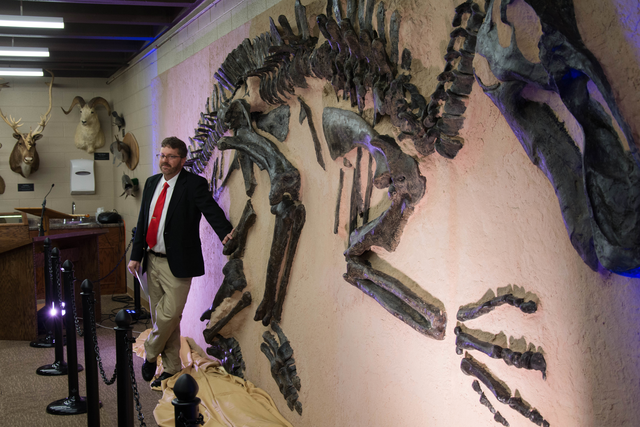
Hillsdale College became one of four places in Michigan to display a full dinosaur skeleton Friday with the addition of an edmontosaurus to the Daniel M. Fisk Museum of Natural History in the Strosacker Science Center.
The nearly complete remains, nicknamed “Linda” for the woman who found the fossil, is a donation from dinosaur-enthusiast Darla Roberts, who Professor of Biology Anthony Swinehart said wanted to help small museums with limited resources. Because dinosaur skeletons are large, expensive, and hard to acquire, only a few small natural history museums are able to display one, Swinehart said.
Several dozen students and faculty gathered in the museum on Friday for the unveiling of the 26-feet-long dinosaur. As a speaker boomed the “Jurassic Park” theme song, Swinehart, the museum’s curator, dropped the curtain covering the skeleton.
“The people present at the unveiling, with the exception of about a dozen who excavated it and prepared it, were the first living organisms to see Linda in about 66 million years,” he said.
The skeleton is mostly complete, with real bones from other skeletons as well as casts from real bones replacing what is missing.
“The only appendage missing from the mount is one of the forelimbs,” Swinehart said.
An amateur fossil hunter, Linda Bergan, discovered the dinosaur in South Dakota in 2013. As a part of an independent study with Swinehart, seniors Matt Hoenig and Hee-Sang Lee assisted Bergan and students from the University of North Georgia with the dinosaur’s excavation.
“Specific bones that I worked on include some of the vertebrae, the pubis — one of the hip bones — and the ribs,” Hoenig said. “There’s no substitute for the hot sun, searing wind, and excitement of finding another bone. Digging up a dinosaur is meticulous, messy, and challenging, and this is what makes it so rewarding.”
Swinehart had contacted Associate Professor of Anthropology Steve Nicklas at the University of North Georgia about opportunities for Hillsdale students to study paleontology in the field. Over the past few years, students have helped excavate several types of dinosaurs, including a tyrannosaurus rex, triceratops, edmontosaurus, and ankylosaurs.
Linda is an edmontosaurus, a type of dinosaur with a signature duck bill. Her kind were herbivores and prey for the tyrannosaurus rex. They could travel on two legs or four.
The museums at the University of Michigan and Michigan State University as well as the Cranbrook Institute of Science all display dinosaur skeletons.
Being only one of a few schools with such an exhibit, Swinehart said he hopes it will attract more students to the museum. It worked for junior Jon Coote, who attended the unveiling, he said.
“I used to pass through there maybe once a week,” Coote said. “But now I’m going to pass through there a lot more frequently.”
Bringing one of these skeletons back to Hillsdale not only fulfills a childhood dream of his, Swinehart said, but also benefits the college by inspiring students.
“Isn’t that a nice Christmas gift?” he said, adding, “We didn’t have a tree big enough to fit it under.”

